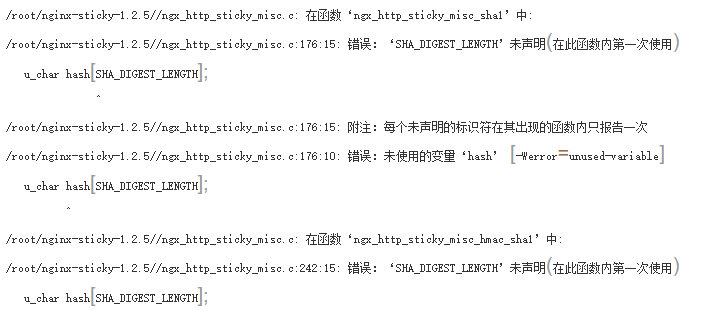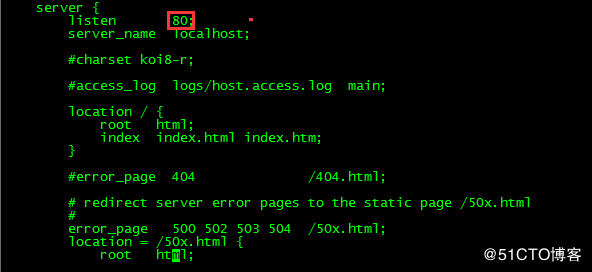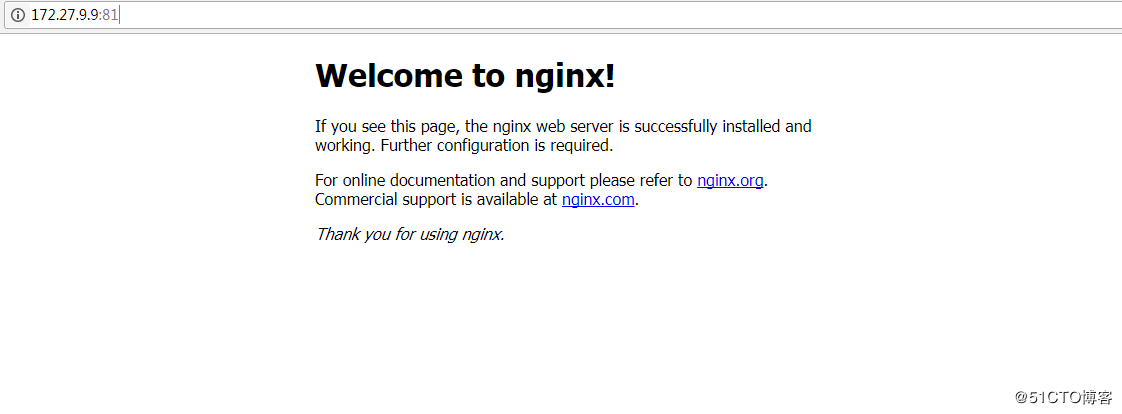1. 安装准备
1.1 gcc安装
安装 nginx 需要先将官网下载的源码进行编译,编译依赖 gcc 环境,如果没有 gcc 环境,则需要安装:
[root@nginx ~]# yum -y install gcc-c++
1.2 pcre安装
PCRE(Perl Compatible Regular Expressions) 是一个Perl库,包括 perl 兼容的正则表达式库。nginx 的 http 模块使用 pcre 来解析正则表达式,所以需要在 linux 上安装 pcre 库,pcre-devel 是使用 pcre 开发的一个二次开发库。nginx也需要此库。
[root@nginx ~]# yum -y install pcre pcre-devel
1.3 zlib安装
zlib 库提供了很多种压缩和解压缩的方式, nginx 使用 zlib 对 http 包的内容进行 gzip ,所以需要在 Centos 上安装 zlib 库。
[root@nginx ~]# yum -y install zlib zlib-devel
1.4 OpenSSL安装
OpenSSL 是一个强大的安全套接字层密码库,囊括主要的密码算法、常用的密钥和证书封装管理功能及 SSL 协议,并提供丰富的应用程序供测试或其它目的使用。
nginx 不仅支持 http 协议,还支持 https(即在ssl协议上传输http),所以需要在 Centos 安装 OpenSSL 库。
[root@nginx ~]# yum -y install openssl openssl-devel
2. Nginx安装
2.1 Nginx版本
下载网址:https://nginx.org/en/download.html
选择最新的稳定版nginx-1.10.3
版本说明:
Mainline version:Mainline 是 Nginx 目前主力在做的版本,可以说是开发版
Stable version:最新稳定版,生产环境上建议使用的版本
Legacy versions:遗留的老版本的稳定版
2.2 Nginx下载
使用wget命令下载
1 [root@nginx ~]# wget -c https://nginx.org/download/nginx-1.10.3.tar.gz
如没有wget命令则安装:
[root@nginx ~]# yum -y install wget
2.3 解压
[root@nginx ~]# tar -zxvf nginx-1.10.3.tar.gz
2.4.1 新建nginx用户和组 (根据自己的需求 可忽略此步)
[root@nginx include]# groupadd nginx [root@nginx include]# useradd -g nginx -d /home/nginx nginx [root@nginx include]# passwd nginx
2.4.2第三方模块安装
本文以安装第三方模块sticky为例,版本为1.,2.5,
下载地址:https://pan.baidu.com/s/1Zpv6axGNUJkkGcam7EoLaQ 密码:6jaq
Sticky是nginx的一个模块,它是基于cookie的一种nginx的负载均衡解决方案,通过分发和识别cookie,来使同一个客户端的请求落在同一台服务器上,默认标识名为route 1.客户端首次发起访问请求,nginx接收后,发现请求头没有cookie,则以轮询方式将请求分发给后端服务器。 2.后端服务器处理完请求,将响应数据返回给nginx。 3.此时nginx生成带route的cookie,返回给客户端。route的值与后端服务器对应,可能是明文,也可能是md5、sha1等Hash值 4.客户端接收请求,并保存带route的cookie。 5.当客户端下一次发送请求时,会带上route,nginx根据接收到的cookie中的route值,转发给对应的后端服务器。
http {
#OK include vhost/xxx.conf;
upstream shop_server{
sticky;
#Sticky是nginx的一个模块,它是基于cookie的一种nginx的负载均衡解决方案,通过分发和识别cookie,来使同一个客户端的请求落在同一台服务器上
# server 192.168.1.23;
server 192.168.1.24;
# server 192.168.1.25;
keepalive 32;
}
上传解压:
[root@nginx ~]# tar -zxvf nginx-goodies-nginx-sticky-module-ng-08a395c66e42..gz [root@nginx ~]# mv nginx-goodies-nginx-sticky-module-ng-08a395c66e42 nginx-sticky-1.2.5
2.4.3 安装
先卸载老版本nginx(若为首次安装可忽略此步)
查找并删除mysql有关的文件
find / -name nginx
rm -rf 上边查找到的路径,多个路径用空格隔开,或者下边一条命令即可
find / -name nginx|xargs rm -rf
安装:
[root@nginx ~]# cd nginx-1.10.3 [root@nginx nginx-1.10.3]# ./configure --user=nginx --group=nginx --prefix=/usr/local/nginx --add-module=/usr/local/nginx-sticky-1.2.5
指定用户、路径和模块配置(可选):
./configure --user=nginx --group=nginx #安装的用户组 --prefix=/usr/local/nginx #指定安装路径 --with-http_stub_status_module #监控nginx状态,需在nginx.conf配置 --with-http_ssl_module #支持HTTPS --with-http_sub_module #支持URL重定向 --with-http_gzip_static_module #静态压缩 --add-module=/usr/local/nginx-sticky-1.2.5 #安装sticky模块
2.5 编译
[root@nginx nginx-1.10.3]# make && make install
报错:
];

解决方法:
修改ngx_http_sticky_misc.c文件,新增#include <openssl/sha.h>和#include <openssl/md5.h>模块
[root@nginx nginx-1.10.3]# sed -i '12a #include <openssl/sha.h>' /usr/local/nginx-sticky-1.2.5/ngx_http_sticky_misc.c
[root@nginx nginx-1.10.3]# sed -i '12a #include <openssl/md5.h>' /usr/local/nginx-sticky-1.2.5/ngx_http_sticky_misc.c
重新编译:
[root@nginx nginx-1.10.3]# make && make install
3.6 nginx命令全局执行设置
[root@nginx bin]# cd /usr/local/nginx/sbin/
[root@nginx sbin]# ln -s /usr/local/nginx/sbin/nginx /usr/local/bin/nginx
4. Nginx相关命令
4.1 版本查看
[root@nginx ~]# nginx -v
nginx version: nginx/1.10.3
4.2 查看加载的模块
[root@nginx ~]# nginx -V
nginx version: nginx/1.10.3
built by gcc 4.8.5 20150623 (Red Hat 4.8.5-28) (GCC)
configure arguments: --add-module=/root/nginx-sticky-1.2.5/
4.3 启停命令
4.3.1 启动
[root@nginx nginx-1.10.3]# /usr/local/nginx/sbin/nginx -c /usr/local/nginx/conf/nginx.conf
4.3.2 停止
[root@nginx nginx-1.12.2]# nginx -s stop
[root@nginx nginx-1.12.2]# nginx -s quit
4.3.3 动态加载
[root@nginx nginx-1.12.2]# nginx -s reload
4.3.4 测试配置文件nginx.conf正确性
[root@nginx ~]# nginx -t
nginx: the configuration file /usr/local/nginx/conf/nginx.conf syntax is ok nginx: configuration file /usr/local/nginx/conf/nginx.conf test is successful
nginx -s quit:此方式停止步骤是待nginx进程处理任务完毕进行停止。
nginx -s stop:此方式相当于先查出nginx进程id再使用kill命令强制杀掉进程。
nginx -s reload:动态加载,当配置文件nginx.conf有变化时执行该命令动态加载。
4.4 开机自启动
编辑/etc/rc.d/rc.local文件,新增一行/usr/local/nginx/sbin/nginx
1 [root@nginx rc.d]# cd /etc/rc.d 2 [root@nginx rc.d]# sed -i '13a /usr/local/nginx/sbin/nginx' /etc/rc.d/rc.local 3 [root@nginx rc.d]# chmod u+x rc.local
5. 更改默认端口
编辑配置文件/usr/local/nginx/conf/nginx.conf,将默认端口80修改为81:
1 [root@nginx ~]# view /usr/local/nginx/conf/nginx.conf

加载配置:
1 [root@nginx ~]# nginx -s reload
6. 访问Nginx
6.1 关闭防火墙
[root@nginx ~]# firewall-cmd --state
running
[root@nginx ~]# systemctl stop firewalld.service
[root@nginx ~]# firewall-cmd --state
not running
6.2 访问Nginx

7.开始配置SSL证书(证书需另行获取,获取的途径很多,如阿里云的服务或第三方服务购买)
进入 conf/nginx.conf 开始配置文件的修改。在修改配置文件之前,最好做一个备份,防止修改错误,也能及时回退错误
7.1、找到第一个监听80端口的server:一下是我修改好的server
1 server { 2 listen 80; 3 server_name 需要访问的域名; 4 5 rewrite ^(.*) https://$server_name$1 permanent; #这句是代表 把 http的域名请求转成https 6 7 #charset koi8-r; 8 #access_log logs/host.access.log main; 9 location / { 10 root html; 11 index index.html index.htm; 12 proxy_pass http://需要访问的域名; #因为这里还是80端口,所以保持http就可以了 13 14 } 15 }
在实际的配置文件中,最好把我上面的备注删除
7.2、第一个server修改好了之后。那么就需要开始配置第二个server。拉到文件的底部。看到有一个https类型的server。而且已经全部被注释封上了,这是我们需要改的第二个server,如图:
这里除了HTTPS server这行之外,其他的 # 删除,启动https模块
1 # HTTPS server 2 # 3 server { 4 listen 443 ssl; 5 server_name 需要访问的域名,这里也不用加https; 6 7 ssl on; 8 9 ssl_certificate /usr/local/nginx/ssl/ssl.pem; #这里是ssl key文件存放的绝对路径,根据自己的文件名称和路径来写 10 ssl_certificate_key /usr/local/nginx/ssl/ssl.key; #这里是ssl key文件存放的绝对路径,根据自己的文件名称和路径来写 11 12 13 ssl_session_cache shared:SSL:1m; 14 ssl_session_timeout 5m; 15 16 ssl_ciphers HIGH:!aNULL:!MD5; 17 ssl_prefer_server_ciphers on; 18 19 location / { 20 proxy_pass http://需要访问的域名:8080/; 21 } 22 }
7.3、检验配置文件是否有错误
[root@localhost sbin]# nginx -t
如果nginx曾经安装过SSL模块,那么应该会显示以下界面:(如果已经显示配置成功,那么可以跳过这一步,直接重启nginx就可以了)
可是大多数第一次安装https证书,都会报错,说缺少SSL模块,如下:

7.4、这时候我们就可以先安装SSL模块:
先确认2个位置:
1)我的nginx是安装在了/usr/local/nginx/下
2)我的nginx的源码包放在了/usr/local/nginx/nginx/nginx-1.8.0下。如果没有的话,重新下载你对应的nginx版本的源码包,找个目录解压
3)目录切换到我们的源码包安装位置:
cd /usr/local/nginx/nginx/nginx-1.8.0
4)执行语句,重新安装ssl模块:
./configure --with-http_ssl_module
5)这时候应该就执行配置成功了。配置成功后,那么就需要编译我们的配置。(注意这里只能用make 而不要用make install,因为执行make install是覆盖安装的意思)
运行:
make
等待执行完成后,我们需要把新编译的nginx模块替换原来的nginx。
6)还是老规矩,先备份旧的nginx,执行语句(这里面复制的文件的路径需要根据你们安装的目录自行修改,如果和我安装的路径是一样的那么可以直接运行该语句):
cp /usr/local/nginx/sbin/nginx /usr/local/nginx/sbin/nginx.bak
先停止nginx进程,然后
cp objs/nginx /usr/local/nginx/sbin/nginx
7)然后就是启动nginx。在启动之前,也可以在测试一次配置文件是否已经生效:
#先切换到sbin目录
cd /usr/local/nginx/sbin/
#检测nginx的配置文件是否有错误
./niginx -t
看到这样的,就是已经成功了
最后启动nginx:
/usr/local/nginx/sbin/nginx -c /usr/local/nginx/conf/nginx.conf
因为刚才替换nginx模块的时候是把nginx进程都杀死了,所以要用上面的命令进行启动,而不能使用reload重启。
nginx正常启动后,我们在访问我们的网站,发现https就已经配置好了:
附上nginx配置文件
1 #user nobody; 2 worker_processes 1; 3 4 #error_log logs/error.log; 5 #error_log logs/error.log notice; 6 #error_log logs/error.log info; 7 8 #pid logs/nginx.pid; 9 10 11 events { 12 worker_connections 1024; 13 } 14 15 16 http { 17 include mime.types; 18 default_type application/octet-stream; 19 20 #log_format main '$remote_addr - $remote_user [$time_local] "$request" ' 21 # '$status $body_bytes_sent "$http_referer" ' 22 # '"$http_user_agent" "$http_x_forwarded_for"'; 23 24 #access_log logs/access.log main; 25 26 sendfile on; 27 #tcp_nopush on; 28 29 #keepalive_timeout 0; 30 keepalive_timeout 65; 31 32 #gzip on; 33 34 server { 35 listen 80; 36 server_name test.feihe.com; 37 #rewrite ^(.*) https://$server_name$1 permanent; #这句是代表 把http的域名请求转成https 38 39 #charset koi8-r; 40 41 #access_log logs/host.access.log main; 42 43 location / { 44 root html/; 45 index index.html index.htm; 46 } 47 48 49 location /coa/ { 50 proxy_pass http://localhost:8080; 51 } 52 53 location /front/ { 54 proxy_pass http://localhost:8080; 55 } 56 57 #error_page 404 /404.html; 58 59 # redirect server error pages to the static page /50x.html 60 # 61 error_page 500 502 503 504 /50x.html; 62 location = /50x.html { 63 root html; 64 } 65 66 # proxy the PHP scripts to Apache listening on 127.0.0.1:80 67 # 68 #location ~ .php$ { 69 # proxy_pass http://127.0.0.1; 70 #} 71 72 # pass the PHP scripts to FastCGI server listening on 127.0.0.1:9000 73 # 74 #location ~ .php$ { 75 # root html; 76 # fastcgi_pass 127.0.0.1:9000; 77 # fastcgi_index index.php; 78 # fastcgi_param SCRIPT_FILENAME /scripts$fastcgi_script_name; 79 # include fastcgi_params; 80 #} 81 82 # deny access to .htaccess files, if Apache's document root 83 # concurs with nginx's one 84 # 85 #location ~ /.ht { 86 # deny all; 87 #} 88 } 89 90 91 # another virtual host using mix of IP-, name-, and port-based configuration 92 # 93 #server { 94 # listen 8000; 95 # listen somename:8080; 96 # server_name somename alias another.alias; 97 98 # location / { 99 # root html; 100 # index index.html index.htm; 101 # } 102 #} 103 104 105 # HTTPS server ssl_protocols SSLv2 SSLv3 TLSv1; 106 107 server { 108 listen 443 ssl; 109 server_name test.feihe.com; 110 111 ssl on; 112 ssl_certificate /usr/local/nginx/ssl/_.xx.com_bundle.crt; #这里是ssl pem文件存放的绝对路径 113 ssl_certificate_key /usr/local/nginx/ssl/_.xx.com.key; #这里是ssl key文件存放的绝对路径 114 115 ssl_session_cache shared:SSL:1m; 116 ssl_session_timeout 5m; 117 118 119 ssl_ciphers HIGH:!aNULL:!MD5; 120 ssl_prefer_server_ciphers on; 121 122 location / { 123 root html/; 124 index index.html index.htm; 125 } 126 127 128 location /coa/ { 129 proxy_pass http://localhost:8080; 130 } 131 132 location /front/ { 133 proxy_pass http://localhost:8080; 134 } 135 } 136 137 }